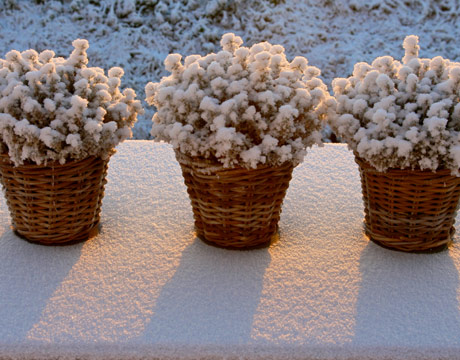Since beginning my academic career, I have moved into and out of more apartments than I can remember — and each one lugging my precious container garden with me as I moved during harvest season. Once there, I had to learn how to store my containers so they wouldn’t break. However, there are several ways to overwinter container gardens. This post tackles outdoor overwintering and care for live plants.
Why overwinter for containers?
Whether using the plants for decoration or trying to grow a few winter treats, winter container gardening is tough. To be successful, you have to protect plants from wind, harsh sunlight and drying out. The biggest challenge, though, is guarding against root damage caused by rapidly fluctuating temperatures. This even applies to plans that are hardy to your zone because being in a container is never like being in the ground — although the top part of a plant has the ability to go dormant, the roots don’t and being in a container means that they are more susceptible to cold damage.
“Essentially any type of container exposes the roots to ambient temperatures,” says Dr. Hannah Mathers, assistant professor in nursery and landscape extension at Ohio State University in Columbus.
Mature roots can gradually get used to the cold, but young, immature roots can’t. In containers, young roots grow on the outer part of the rootball. When exposed to the cold, young roots are unable to acclimate and die back.
So, what’s a savvy gardener to do?
There are three main things that experts have always recommended.
First, when choosing a pot, bigger is better. Reason? The soil in a 15-gallon container will insulate the roots better than that in a one-gallon pot because the smaller pot freezes faster. A good rule of thumb: select a larger-sized pot that also has a thickness of one inch or more. Bonus: larger pots dry out less quickly than smaller pots.
Second, plant the container as early as possible in order to allow plants to acclimate and harden off. If plants are healthy and go into winter with mature roots, they have a much better tolerance of winter stress.
Want to give your plants more time to harden off? Select a container plants that are hardy to two zones, cooler than your hardiness zone. This will buy you some time before you need to really start worrying about your new plant.
Third, avoid exposing plants to the vicious freeze/thaw cycle, which can cause significant injury to roots and may even heave the plant out of the pot. To avoid this, place pots on soil instead of pavement. For plants in the ground, the main source of heat for roots is the heat of the earth. For containers on pavement, the sun can warm the pavement considerably, elevating the temperature of the rootball. This is followed by a drop in temperatures at night. The fluctuation exposes containers on pavement to freezing and thawing.
Another step to avoid freezing is to prop the planter up on legs and forego a saucer. This allows water to drain away from the planter completely so it reduces the chance of it freezing at night when the temperatures drop.
A note on pots: Different pots will react to the freeze-thaw cycle in different ways. Terra-cotta and ceramic are the most susceptible to breaking, but if you really like the looks of them, treat them well. One way to do this is with a layer of pool paint that will prevent the moisture from entering the pores in the pots surface, thus reducing the possibility for freeze-thaw.
Concrete, wood, plastic, and metal are all very durable and will last the longest over multiple winters. Choose thick walled, heavy pots for more insulation while reducing the likelihood of pots being blown over by strong winds.
“Zone 6 Bill” or Bill the Gardener also had an ingenious treatment for his winter gardening problems. Take a look at this YouTube video for an idea of how to help your soil from too much heaving when the freezing and thawing begin.
While I’ve not tried this personally, I think it would work. I’d love to find out if anyone has tried this, and what they think of it.
Location is important too.
In winter the greatest temperature swings are on the south side of the house, which increases the extremes of the freeze-thaw cycle. To minimize this, you’d place containers on the north side of the property. But, what if you don’t have a north side (like I currently don’t presently in my apartment)? Place them in a walled areas, corners, or anywhere else they will receive some measure of protection from desiccating winds and temperature extremes.
Winter watering
There is typically less rainfall during the winter months, so your plants are more likely to dry out. Broad-leaved evergreens (holly, laurel, and others) are especially in need, but that doesn’t mean ignore the needled conifers either. Even they will need a little TLC.
The ideal time to water is during the day when temperatures are above freezing when it’s not going to be overly windy. Windy weather can actually dry out the soil and plant further, making it that much harder for your plant. Of course, there is a caveat to this general rule.
“When water freezes, it gives off heat. There’s a latent heat release,” Hannah says. “Even if temperatures are at freezing and the pot is dry, it’s important to water because it will help to better protect the plants’ roots.”
What will you be overwintering?
Next week I’ll write up a few more ways to overwinter and protect your pots, not necessarily plants for those of us that don’t want to overwinter an entire garden… or at least don’t have perennials in the pots. Until then, what will you be growing this winter?

